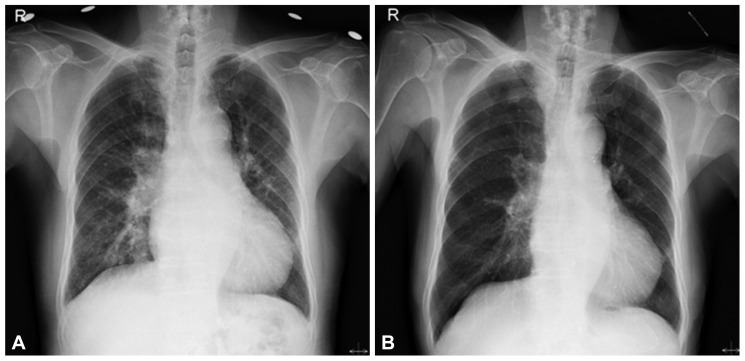Patent ductus arteriosus chest x ray
Jump to navigation
Jump to search
|
Patent Ductus Arteriosus Microchapters |
|
Differentiating Patent Ductus Arteriosus from other Diseases |
|---|
|
Diagnosis |
|
Treatment |
|
Medical Therapy |
|
Case Studies |
|
Patent ductus arteriosus chest x ray On the Web |
|
American Roentgen Ray Society Images of Patent ductus arteriosus chest x ray |
|
Risk calculators and risk factors for Patent ductus arteriosus chest x ray |
Editor-In-Chief: C. Michael Gibson, M.S., M.D. [1]; Associate Editor-In-Chief: Priyamvada Singh, M.B.B.S. [2], Cafer Zorkun, M.D., Ph.D. [3], Ramyar Ghandriz MD[4] Assistant Editor-In-Chief: Kristin Feeney, B.S. [5]
Overview
The findings on chest x ray depends on the degree of shunting between left and right system.
Chest X Ray
Small-Sized PDA
- Normal heart size and vascularity.[1]
Medium-Sized PDA
- Occasionally, the ductus can be seen as a separate convexity between the aortic knob and the pulmonary artery segments.[2]
- Cardiomegaly related to left atrium and left ventricular volume overloads.
- Increase in the pulmonary vascular markings.
- The ascending aorta may be prominent due to increased flow.
Large-Sized PDA
- Similar to a PDA complicated by pulmonary vascular disease.[3][4]
- Left ventricular overload regresses by adolescence and the heart size may revert to normal.
- The apex may be tilted upward reflecting right ventricular hypertrophy.
- The pulmonary trunk and its branches are markedly dilated and may show central calcification, but in the outer third there is an abrupt decrease in vascularity.

References
- ↑ Mak, MS; Ong, CC; Tay, EL; Teo, LL (2014). "Clinics in diagnostic imaging (155)". Singapore Medical Journal. 55 (09): 462–467. doi:10.11622/smedj.2014113. ISSN 0037-5675.
- ↑ Davis, Peter (1995). "Precision and Accuracy of Clinical and Radiological Signs in Premature Infants at Risk of Patent Ductus Arteriosus". Archives of Pediatrics & Adolescent Medicine. 149 (10): 1136. doi:10.1001/archpedi.1995.02170230090013. ISSN 1072-4710.
- ↑ Wiyono, S. A.; Witsenburg, M.; de Jaegere, P. P. T.; Roos-Hesselink, J. W. (2008). "Patent ductus arteriosus in adults". Netherlands Heart Journal. 16 (7): 255–259. doi:10.1007/BF03086157. ISSN 1568-5888.
- ↑ Adler NA, Snoey ER, Barbant SD (2013). "An unusual cause of congestive heart failure in a young woman". J Emerg Med. 45 (6): e193–6. doi:10.1016/j.jemermed.2013.05.027. PMID 24094805.
- ↑ "A Case of Patent Ductus Arteriosus with Congestive Heart Failure in a 80-Year-Old Man".